ST elevation myocardial infarction EKG examples: Difference between revisions
Rim Halaby (talk | contribs) No edit summary |
Rim Halaby (talk | contribs) No edit summary |
||
| Line 23: | Line 23: | ||
[[Image:STEMI 11.jpg|center|800px]] | [[Image:STEMI 11.jpg|center|800px]] | ||
Copyleft image obtained courtesy of, http://en.ecgpedia.org/wiki/Main_Page | Copyleft image obtained courtesy of, http://en.ecgpedia.org/wiki/Main_Page | ||
---- | |||
Shown below is an EKG demonstrating acute anterior myocardial infarction and [[left anterior hemiblock]] depicting [[ST elevation]] in [[precordial lead]]s. | |||
[[Image:STEMI 14.jpg|center|800px]] | |||
Copyleft image obtained courtesy of, http://en.ecgpedia.org/wiki/Main_Page | |||
---- | |||
Shown below is an EKG demonstrating old anterior myocardial infarction and [[bifascicular block]] ([[RBBB]] and [[LAHB]]) as indicated in the anterior chest leads. | |||
[[Image:STEMI 15.jpg|center|800px]] | |||
Copyleft image obtained courtesy of, http://en.ecgpedia.org/wiki/Main_Page | |||
---- | |||
Shown below is an EKG illustrating acute MI with proximal LAD occlusion depicting [[ST elevation]] in anterior [[precordial lead]]s. | |||
[[Image:STEMI 16.jpg|center|800px]] | |||
Copyleft image obtained courtesy of, http://en.ecgpedia.org/wiki/Main_Page | |||
---- | |||
Shown below is an EKG demonstrating a 2 days old anterior infarction with [[Q wave]]s in V1-V4 with persisting [[ST elevation]], a sign of left [[ventricular aneurysm]] formation. | |||
[[Image:STEMI 17.jpg|center|800px]] | |||
Copyleft image obtained courtesy of, http://en.ecgpedia.org/wiki/Main_Page | |||
---- | |||
Shown below is an EKG demonstrating a 2 weeks old anterior infarction with [[Q wave]]s in [[Electrocardiogram#Precordial|V2]]-[[Electrocardiogram#Precordial|V4]] and persisting ST elevation, a sign of left [[ventricular aneurysm]] formation. | |||
[[Image:STEMI 18.jpg|center|800px]] | |||
Copyleft image obtained courtesy of, http://en.ecgpedia.org/wiki/Main_Page | |||
---- | |||
Shown below is an EKG demonstrating a large anterior wall infarction on admission. This image depicts [[ST elevation]] in [[Electrocardiogram#Precordial|V2]]-[[Electrocardiogram#Precordial|V5]] leads. | |||
[[Image:STEMI 19.jpg|center|800px]] | |||
Copyleft image obtained courtesy of, http://en.ecgpedia.org/wiki/Main_Page | |||
---- | |||
Shown below is an EKG showing [[ST elevation]] in the anterior [[precordial lead]]s, low voltages in all the leads, poor R wave progression in the precordial leads. | |||
[[Image:AMI_anterior_LAD.jpg|center|800px]] | |||
Copyleft image obtained courtesy of, http://en.ecgpedia.org/wiki/File:De-AMI_anterior_LAD_2days.jpg | |||
---- | |||
Shown below is an [[EKG]] demonstrating [[ST elevation|ST segment elevation]] in [[precordial lead]]s signifying anterior myocardial infarction. | |||
[[Image:De-AMI_anterior.png|center|500px]] | |||
Copyleft image obtained courtesy of, http://en.ecgpedia.org/wiki/File:De-AMI_anterior.png | |||
---- | |||
Shown below is an EKG showing [[sinus rhythm]] with abnormal [[QRS]] and a [[Q wave]] in lead [[Electrocardiogram#Precordial|V2]] which is suggestive of a previous anterior wall myocardial infarction. | |||
[[Image:Previous_anterior_wall_myocardial_infartion..jpg|center|800px]] | |||
Copyleft image obtained courtesy of, http://en.ecgpedia.org/wiki/File:E289.jpg | |||
---- | ---- | ||
| Line 33: | Line 84: | ||
---- | ---- | ||
Shown below is an EKG demonstrating acute myocardial infarction in in a patient with a pacemaker and [[LBBB]]. Concordant ST elevation in [[Electrocardiogram#Precordial|V5]]-[[Electrocardiogram#Precordial|V6]] are clearly visible. There is discordant [[ST elevation|ST segment elevation]] > 5 mm in lead [[Electrocardiogram#Precordial|V3]]. | |||
[[Image:STEMI 25.jpg|center|800px]] | |||
Copyleft image obtained courtesy of,http://en.ecgpedia.org/wiki/Main_Page | |||
---- | |||
Shown below is an EKG demonstrating findings in the same patient as in the first example 2 months before the myocardial infarction. Normal [[LBBB]] pattern. | |||
[[Image:STEMI 25 a.jpg|center|800px]] | |||
Copyleft image obtained courtesy of,http://en.ecgpedia.org/wiki/Main_Page | |||
---- | |||
Shown below is an EKG showing ST elevation MI. | |||
[[Image:STEMI_29.jpg|center|800px]] | |||
Copyleft image obtained courtesy of, http://en.ecgpedia.org/wiki/File:De-KJcasus12.jpg | |||
---- | |||
===Inferior Myocardial Infarction=== | ===Inferior Myocardial Infarction=== | ||
Shown below is an EKG demonstrating [[ST elevation]] in the [[Precordial lead|precordial]] and [[limb lead]]s depicting acute inferior MI. | Shown below is an EKG demonstrating [[ST elevation]] in the [[Precordial lead|precordial]] and [[limb lead]]s depicting acute inferior MI. | ||
| Line 49: | Line 114: | ||
Copyleft image obtained courtesy of, http://en.ecgpedia.org/wiki/Main_Page | Copyleft image obtained courtesy of, http://en.ecgpedia.org/wiki/Main_Page | ||
---- | ---- | ||
Shown below is an EKG demonstrating [[RBBB]] and inferior MI. Note to [[left axis deviation]]. | |||
[[Image:STEMI 22.jpg|center|800px]] | |||
Copyleft image obtained courtesy of, http://en.ecgpedia.org/wiki/Main_Page | |||
---- | |||
Shown below is an EKG demonstrating lead [[Electrocardiogram#Precordial|V4R]] in a patient with [[RBBB]] and inferior MI, which clearly shows [[ST elevation]]. | |||
[[Image:STEMI 23.jpg|center|800px]] | |||
Copyleft image obtained courtesy of,http://en.ecgpedia.org/wiki/Main_Page | |||
---- | |||
Shown below is an EKG demonstrating atrial fibrillation with inferior-posterior-lateral myocardial infarction and incomplete [[right bundle branch block]]. Lead I shows ST depression, suggestive of right coronary artery involvement. | |||
[[Image:STEMI 27.jpg|center|800px]] | |||
Copyleft image obtained courtesy of, http://en.ecgpedia.org/wiki/Main_Page | |||
---- | |||
Shown below is an EKG showing [[ST elevation]] in inferior leads. | |||
[[Image:STEMI_30.jpg|center|800px]] | |||
Copyleft image obtained courtesy of, http://en.ecgpedia.org/wiki/File:De-Ami0007.jpg | |||
---- | |||
Shown below is an EKG showing ST elevation MI. | |||
[[Image:STEMI_32.jpg|center|800px]] | |||
Copyleft image obtained courtesy of, http://en.ecgpedia.org/wiki/File:De-KJcasus16.jpg | |||
---- | |||
Shown below is an EKG showing ST elevation in inferior leads. | |||
[[Image:STEMI_33.jpg|center|800px]] | |||
Copyleft image obtained courtesy of, http://en.ecgpedia.org/wiki/File:De-Ami0011.jpg | |||
---- | |||
===Posterior Myocardial Infarction=== | ===Posterior Myocardial Infarction=== | ||
| Line 71: | Line 166: | ||
---- | ---- | ||
Shown below is an EKG with sinus [[bradycardia]] with [[first degree AV block]] and inferior-posterior-lateral myocardial infarction. | |||
[[Image:STEMI 8.jpg|center|800px]] | [[Image:STEMI 8.jpg|center|800px]] | ||
Copyleft image obtained courtesy of, http://en.ecgpedia.org/wiki/Main_Page | Copyleft image obtained courtesy of, http://en.ecgpedia.org/wiki/Main_Page | ||
| Line 81: | Line 176: | ||
---- | ---- | ||
Shown below is an EKG illustrating inferior-posterior myocardial infarction with [[complete AV block]] and [[ventricular escape beat|ventricular escape rhythm]] with [[RBBB]] pattern and left axis, followed by [[sinus rhythm]]. | |||
[[Image:STEMI 13.jpg|center|800px]] | |||
Copyleft image obtained courtesy of, http://en.ecgpedia.org/wiki/Main_Page | |||
---- | |||
Shown below is an EKG demonstrating [[atrial fibrillation]] and inferior-posterior myocardial infarction. | |||
[[Image:STEMI 20.jpg|center|800px]] | |||
Copyleft image obtained courtesy of, http://en.ecgpedia.org/wiki/Main_Page | |||
---- | |||
Shown below is an EKG demonstrating inferior-posterior-lateral myocardial infarction with a nodal escape rhythm | |||
[[Image:STEMI 21.jpg|center|800px]] | |||
Copyleft image obtained courtesy of, http://en.ecgpedia.org/wiki/Main_Page | |||
---- | |||
Shown below is an EKG showing ST elevation MI. | |||
[[Image:STEMI_31.jpg|center|800px]] | |||
Copyleft image obtained courtesy of, http://en.ecgpedia.org/wiki/File:De-KJcasus13.jpg | |||
---- | |||
Shown below is an EKG showing ST elevation MI. | |||
[[Image:STEMI_34.jpg|center|800px]] | |||
Copyleft image obtained courtesy of, http://en.ecgpedia.org/wiki/File:De-Ami0010.jpg | |||
---- | |||
===Right Ventricular Myocardial Infarction=== | ===Right Ventricular Myocardial Infarction=== | ||
| Line 94: | Line 214: | ||
---- | ---- | ||
Shown below is an EKG demonstrating clear [[ST elevation]] in the right [[precordial lead]]s. A [[coronary angiography]] revealed a proximal right coronary artery occlusion. | |||
[[Image:STEMI 20 a.jpg|center|800px]] | |||
Copyleft image obtained courtesy of, http://en.ecgpedia.org/wiki/Main_Page | |||
---- | |||
==References== | ==References== | ||
Revision as of 22:19, 11 March 2014
|
ST Elevation Myocardial Infarction Microchapters |
|
Differentiating ST elevation myocardial infarction from other Diseases |
|
Diagnosis |
|
Treatment |
|
|
Case Studies |
|
ST elevation myocardial infarction EKG examples On the Web |
|
Directions to Hospitals Treating ST elevation myocardial infarction |
|
Risk calculators and risk factors for ST elevation myocardial infarction EKG examples |
Editor-In-Chief: C. Michael Gibson, M.S., M.D. [1]
EKG Examples
Shown below is an EKG demonstrating the evolution of an infarct on the EKG. ST elevation, Q wave formation, T wave inversion, normalization with a persistent Q wave suggest STEMI.

Copyleft image obtained courtesy of ECGpedia, http://en.ecgpedia.org/wiki/File:AMI_evolutie.png
Anterior Myocardial Infarction
Shown below is an EKG demonstrating loss of R waves throughout the anterior wall (V1-V6). QS complexes in V3-V5. ST elevation in V1-V5 with terminal negative T waves.
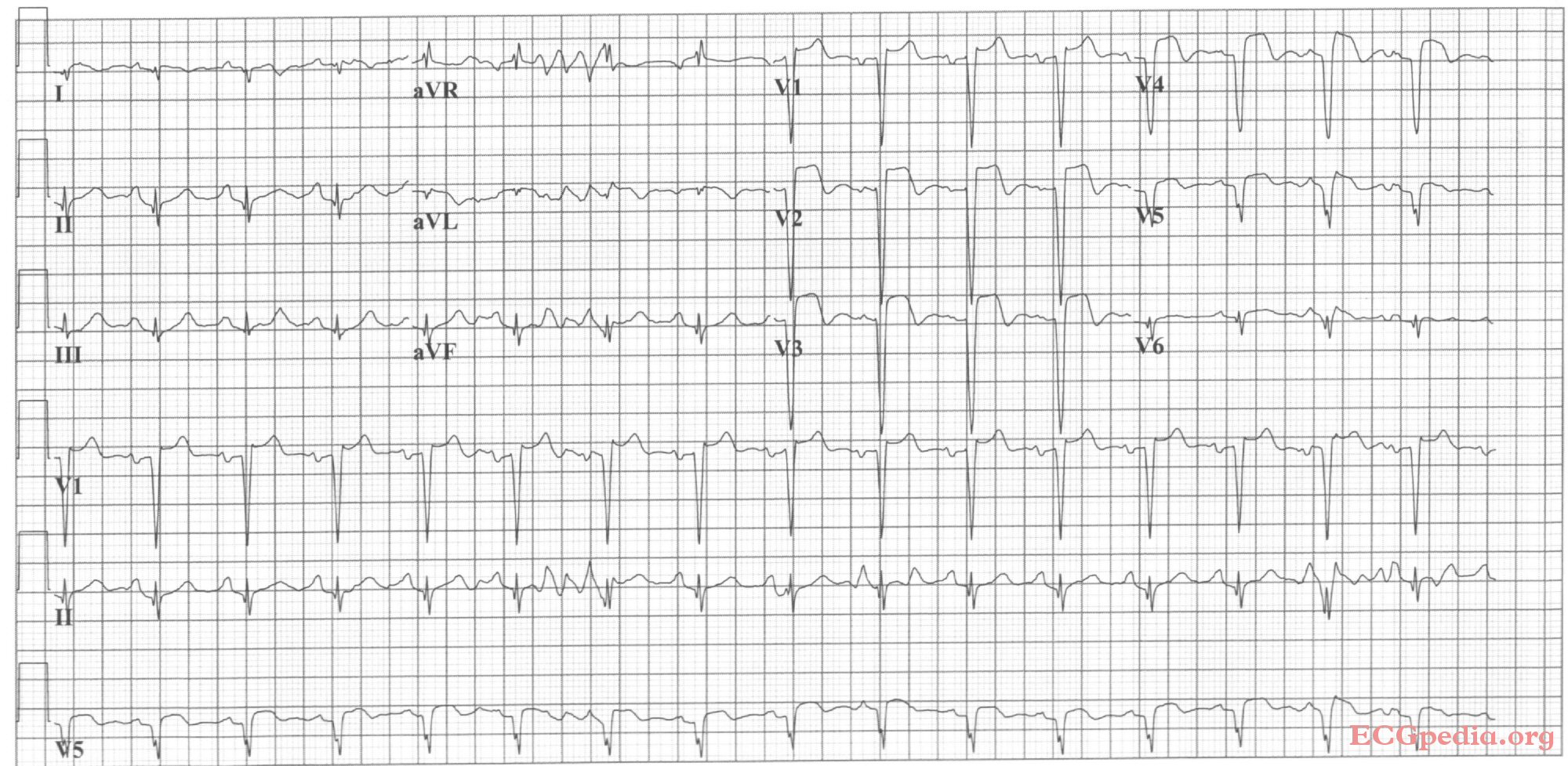
Copyleft image obtained courtesy of, http://en.ecgpedia.org/wiki/Main_Page
Shown below is an EKG demonstrating acute anterior MI. LAD artery occlusion.
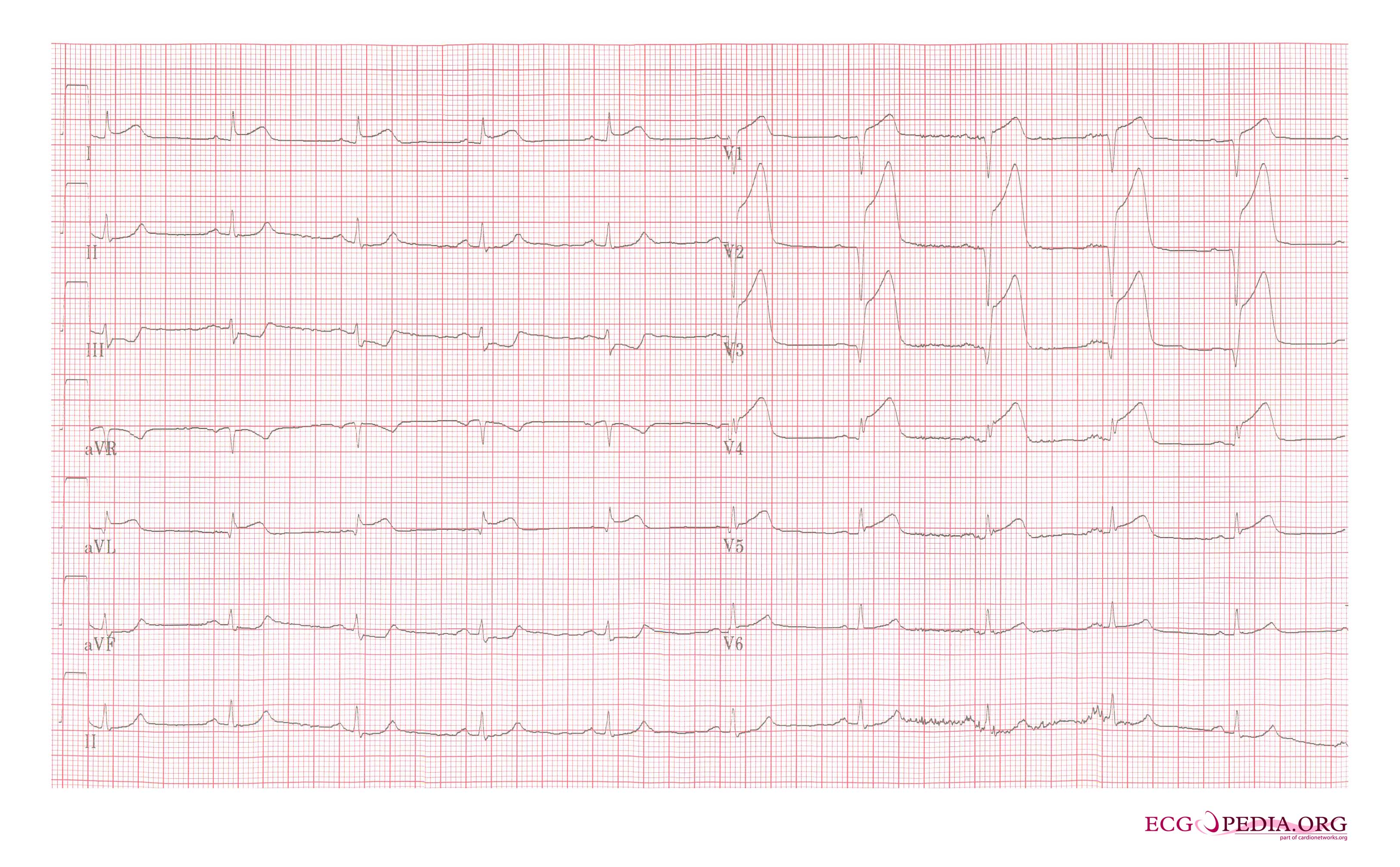
Copyleft image obtained courtesy of, http://en.ecgpedia.org/wiki/Main_Page
Shown below is an EKG showing sinus rhythm with anteroseptal myocardial infarction depicting ST elevation in V1-V6 and in lead I.

Copyleft image obtained courtesy of, http://en.ecgpedia.org/wiki/Main_Page
Shown below is an EKG demonstrating acute anterior myocardial infarction and left anterior hemiblock depicting ST elevation in precordial leads.

Copyleft image obtained courtesy of, http://en.ecgpedia.org/wiki/Main_Page
Shown below is an EKG demonstrating old anterior myocardial infarction and bifascicular block (RBBB and LAHB) as indicated in the anterior chest leads.

Copyleft image obtained courtesy of, http://en.ecgpedia.org/wiki/Main_Page
Shown below is an EKG illustrating acute MI with proximal LAD occlusion depicting ST elevation in anterior precordial leads.

Copyleft image obtained courtesy of, http://en.ecgpedia.org/wiki/Main_Page
Shown below is an EKG demonstrating a 2 days old anterior infarction with Q waves in V1-V4 with persisting ST elevation, a sign of left ventricular aneurysm formation.
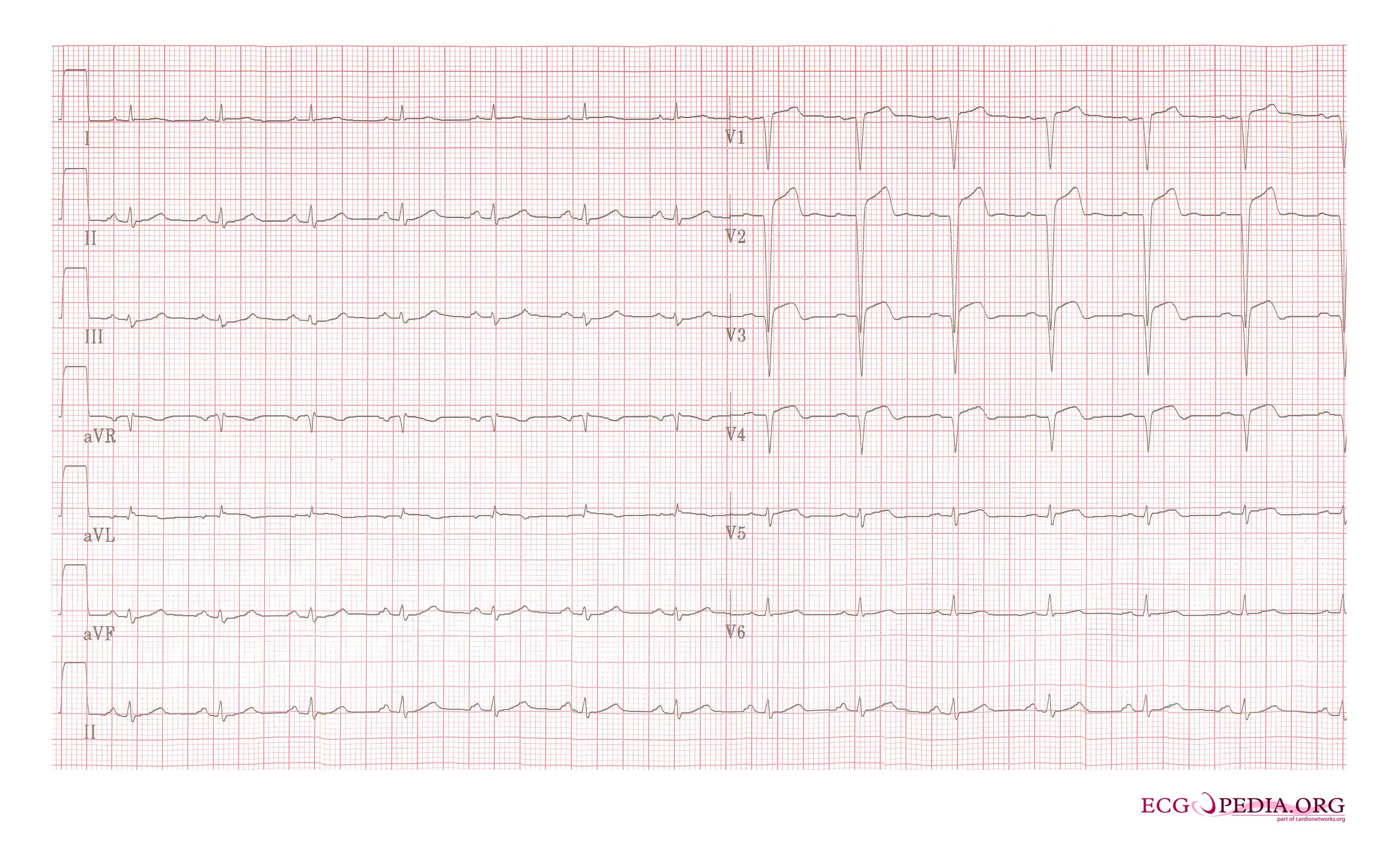
Copyleft image obtained courtesy of, http://en.ecgpedia.org/wiki/Main_Page
Shown below is an EKG demonstrating a 2 weeks old anterior infarction with Q waves in V2-V4 and persisting ST elevation, a sign of left ventricular aneurysm formation.

Copyleft image obtained courtesy of, http://en.ecgpedia.org/wiki/Main_Page
Shown below is an EKG demonstrating a large anterior wall infarction on admission. This image depicts ST elevation in V2-V5 leads.
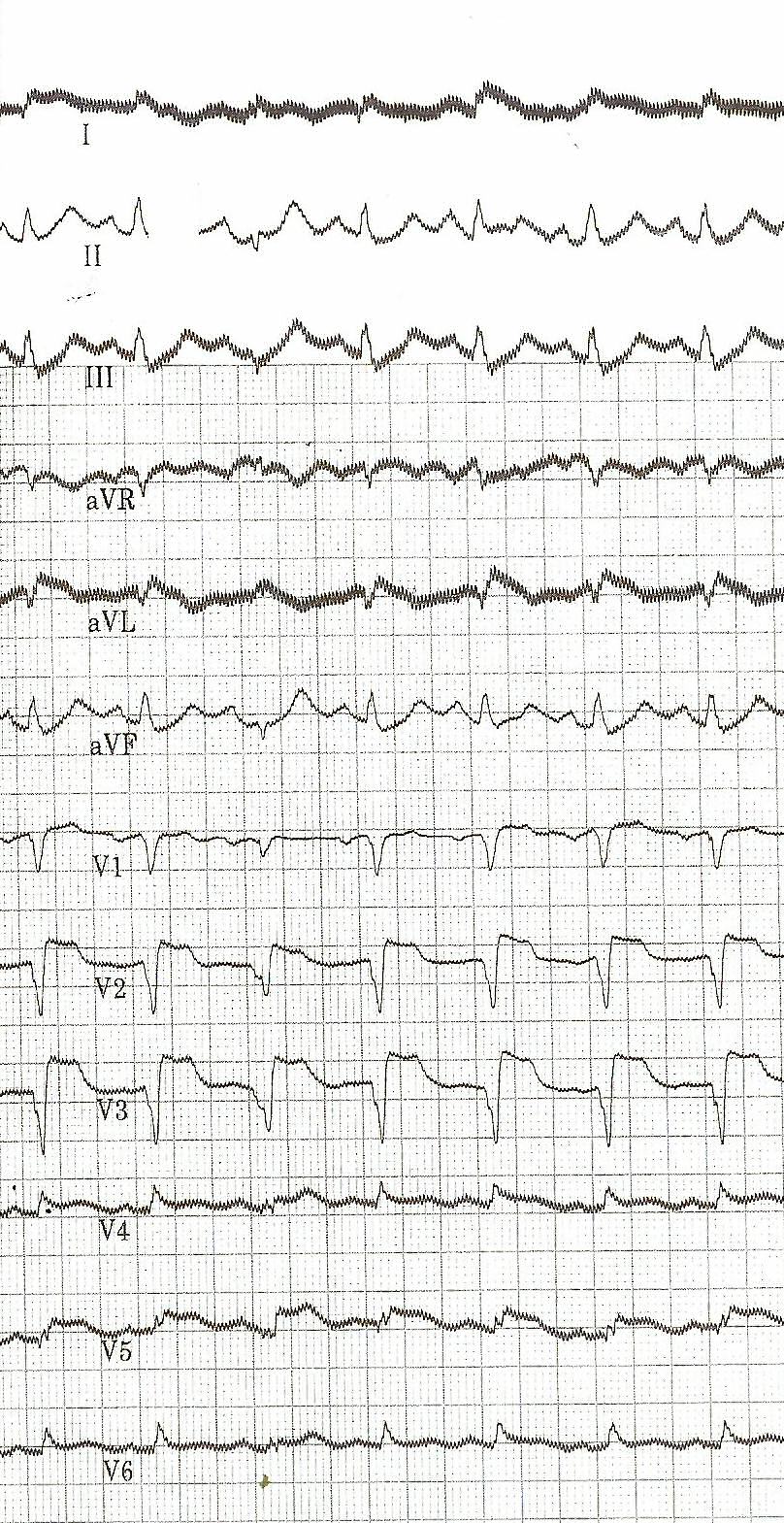
Copyleft image obtained courtesy of, http://en.ecgpedia.org/wiki/Main_Page
Shown below is an EKG showing ST elevation in the anterior precordial leads, low voltages in all the leads, poor R wave progression in the precordial leads.
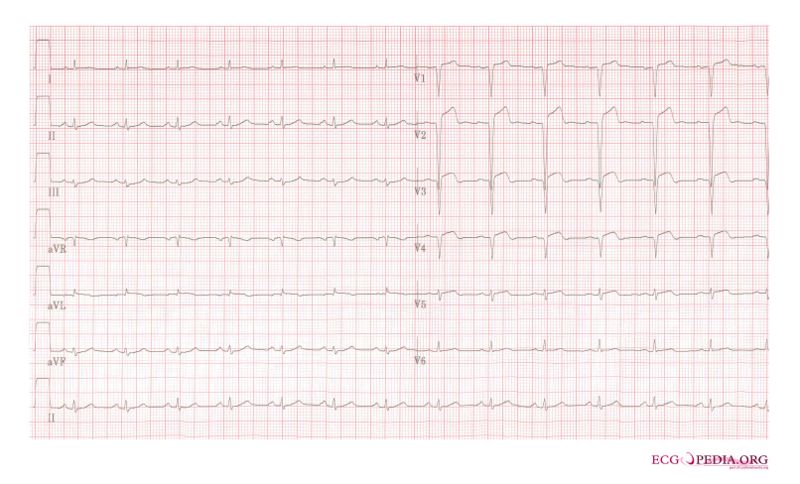
Copyleft image obtained courtesy of, http://en.ecgpedia.org/wiki/File:De-AMI_anterior_LAD_2days.jpg
Shown below is an EKG demonstrating ST segment elevation in precordial leads signifying anterior myocardial infarction.
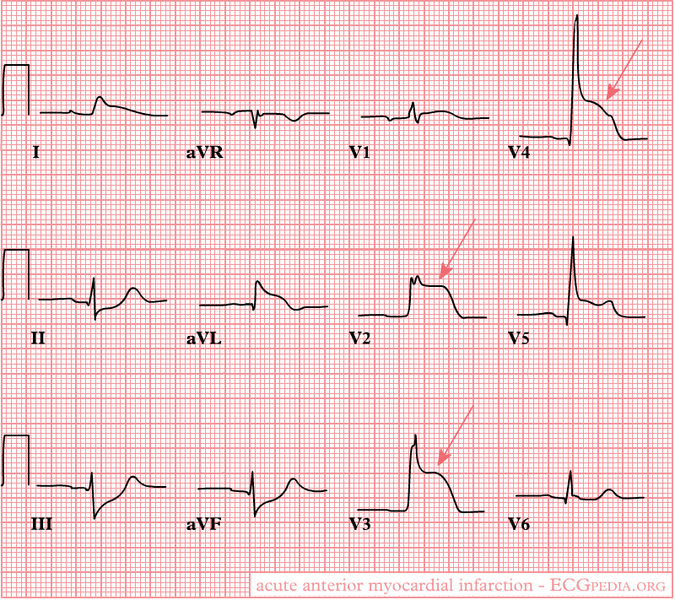
Copyleft image obtained courtesy of, http://en.ecgpedia.org/wiki/File:De-AMI_anterior.png
Shown below is an EKG showing sinus rhythm with abnormal QRS and a Q wave in lead V2 which is suggestive of a previous anterior wall myocardial infarction.

Copyleft image obtained courtesy of, http://en.ecgpedia.org/wiki/File:E289.jpg
Anterolateral Myocardial Infarction
Shown below is an EKG demonstrating sinus rhythm. The remarkable feature is the poor R wave progression in the V1 and V2 leads and the ST elevation and T wave changes in leads V1 to V4 and I and aVL. The cardiogram suggests an anterior/ lateral MI possibly acute. There is also terminal P wave negativity in V1 suggesting a left atrial abnormality.
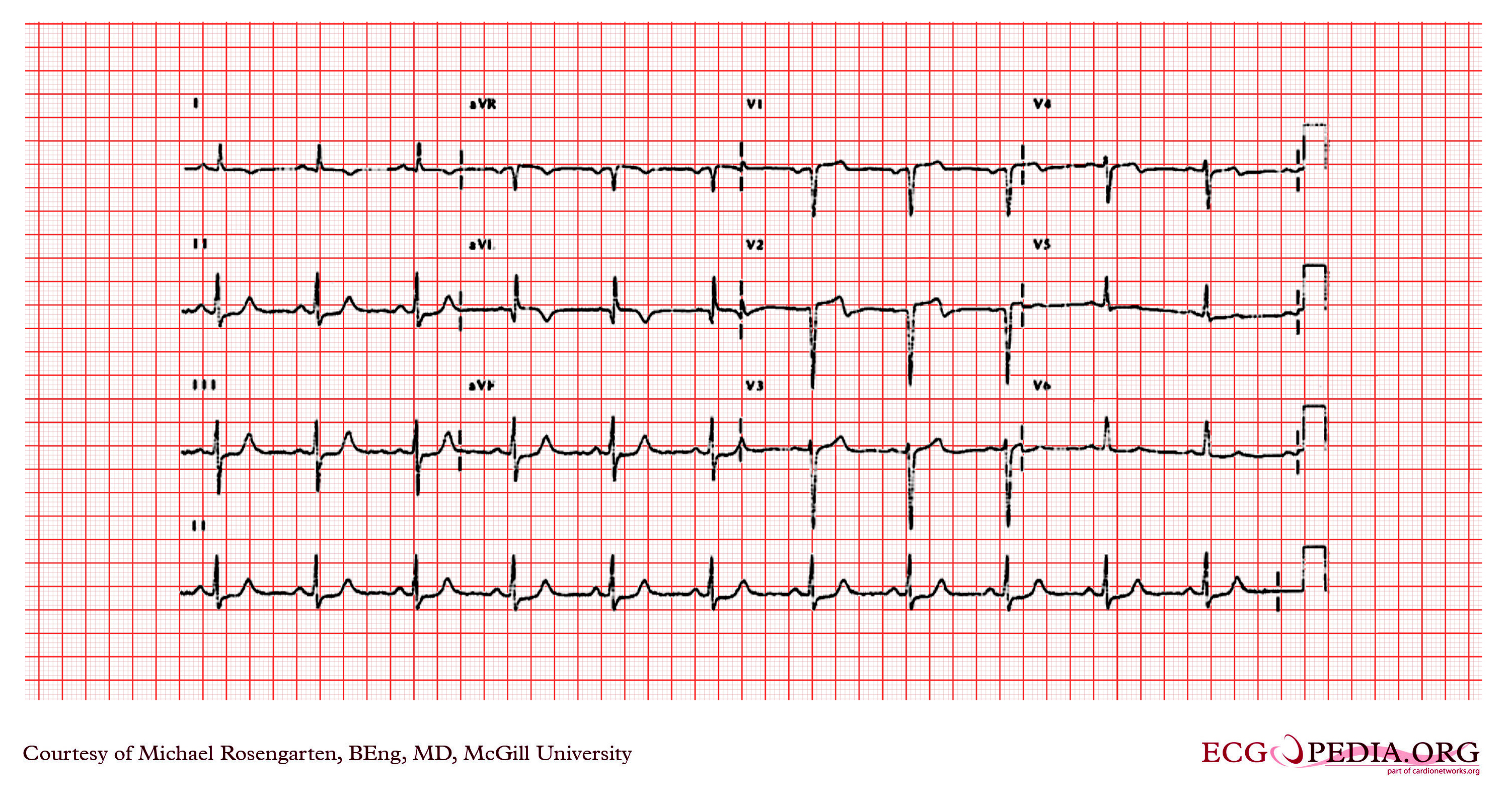
Copyleft image obtained courtesy of, http://en.ecgpedia.org/wiki/File:E209.jpg
Shown below is an EKG demonstrating acute myocardial infarction in in a patient with a pacemaker and LBBB. Concordant ST elevation in V5-V6 are clearly visible. There is discordant ST segment elevation > 5 mm in lead V3.

Copyleft image obtained courtesy of,http://en.ecgpedia.org/wiki/Main_Page
Shown below is an EKG demonstrating findings in the same patient as in the first example 2 months before the myocardial infarction. Normal LBBB pattern.
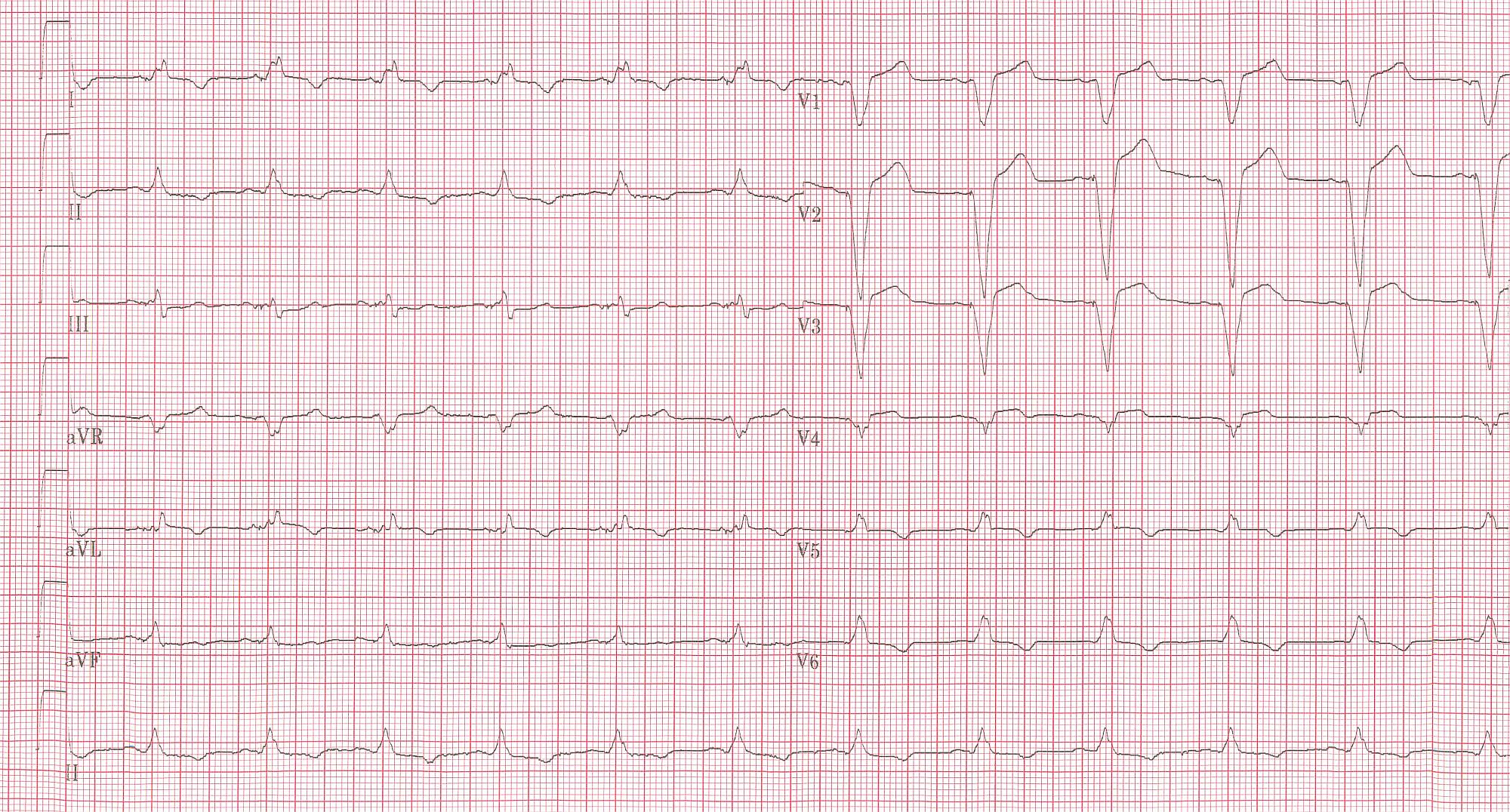
Copyleft image obtained courtesy of,http://en.ecgpedia.org/wiki/Main_Page
Shown below is an EKG showing ST elevation MI.
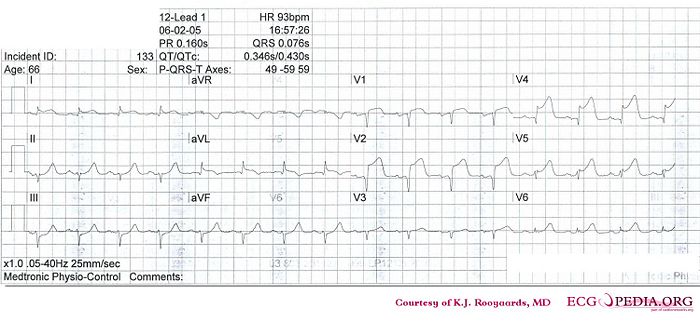
Copyleft image obtained courtesy of, http://en.ecgpedia.org/wiki/File:De-KJcasus12.jpg
Inferior Myocardial Infarction
Shown below is an EKG demonstrating ST elevation in the precordial and limb leads depicting acute inferior MI.
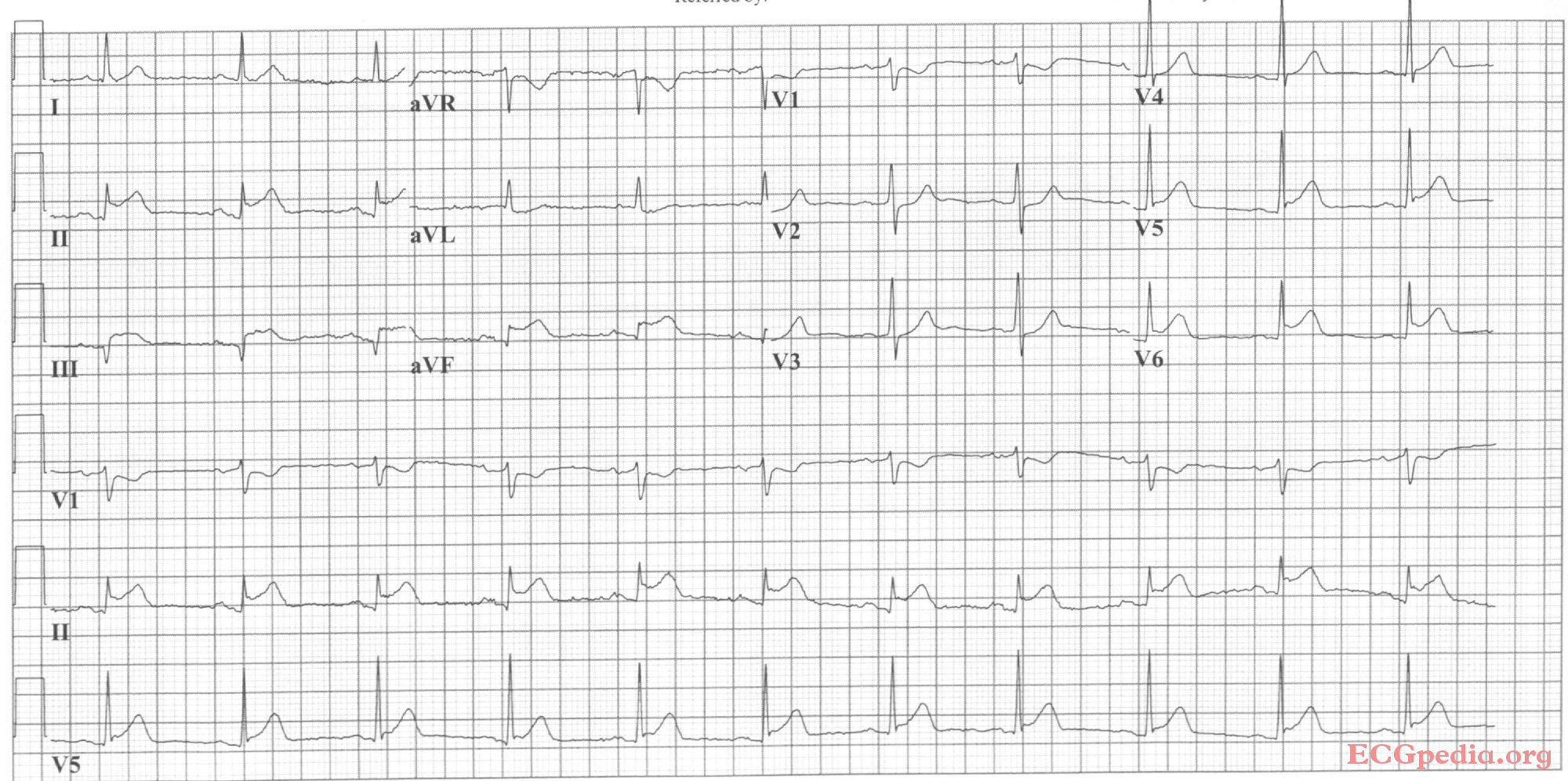
Copyleft image obtained courtesy of, http://en.ecgpedia.org/wiki/Main_Page
Shown below is an EKG demonstrating changes during acute inferior MI depicting ST elevation in leads II, III and aVF.

Copyleft image obtained courtesy of, http://en.ecgpedia.org/wiki/Main_Page
Shown below is an EKG demonstrating RBBB and inferior MI. Note to left axis deviation.
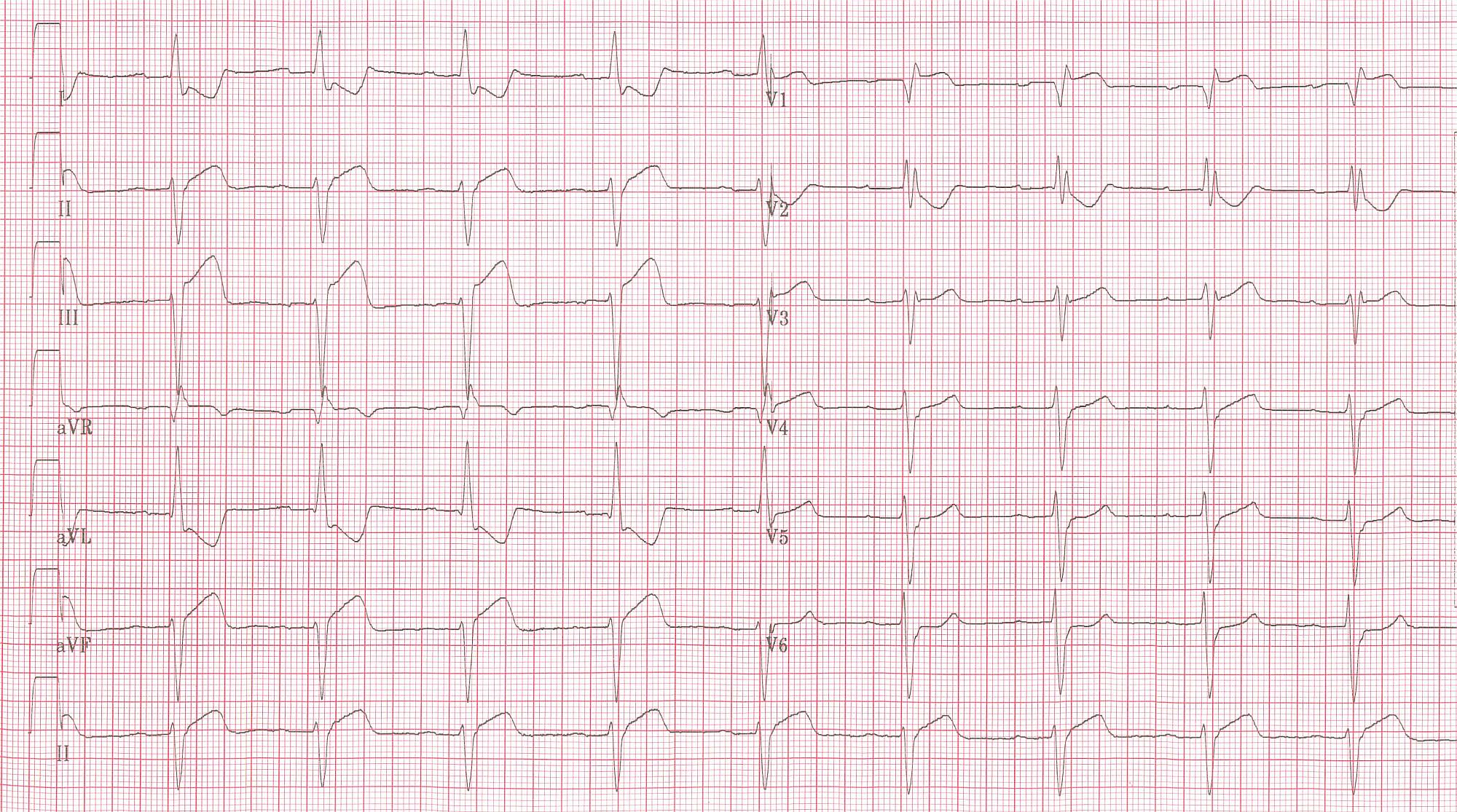
Copyleft image obtained courtesy of, http://en.ecgpedia.org/wiki/Main_Page
Shown below is an EKG demonstrating lead V4R in a patient with RBBB and inferior MI, which clearly shows ST elevation.

Copyleft image obtained courtesy of,http://en.ecgpedia.org/wiki/Main_Page
Shown below is an EKG demonstrating atrial fibrillation with inferior-posterior-lateral myocardial infarction and incomplete right bundle branch block. Lead I shows ST depression, suggestive of right coronary artery involvement.

Copyleft image obtained courtesy of, http://en.ecgpedia.org/wiki/Main_Page
Shown below is an EKG showing ST elevation in inferior leads.
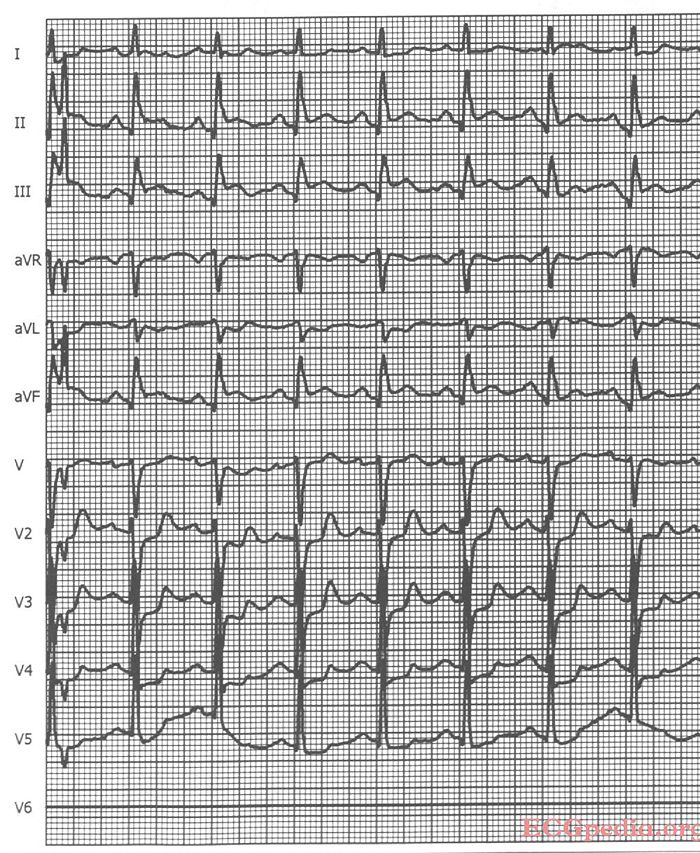
Copyleft image obtained courtesy of, http://en.ecgpedia.org/wiki/File:De-Ami0007.jpg
Shown below is an EKG showing ST elevation MI.

Copyleft image obtained courtesy of, http://en.ecgpedia.org/wiki/File:De-KJcasus16.jpg
Shown below is an EKG showing ST elevation in inferior leads.
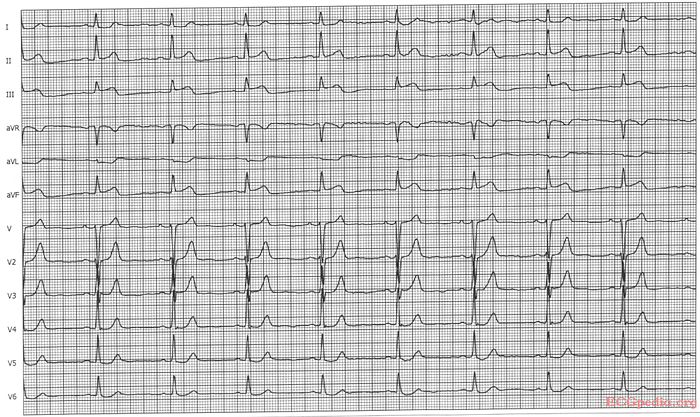
Copyleft image obtained courtesy of, http://en.ecgpedia.org/wiki/File:De-Ami0011.jpg
Posterior Myocardial Infarction
Shown below is an EKG with ST elevation in II, III, aVF (in III > II), ST depression in I, aVL, V2. Tall R in V2, otherwise normal QRS morphology. The findings are suggestive of acute posteroinferior MI.
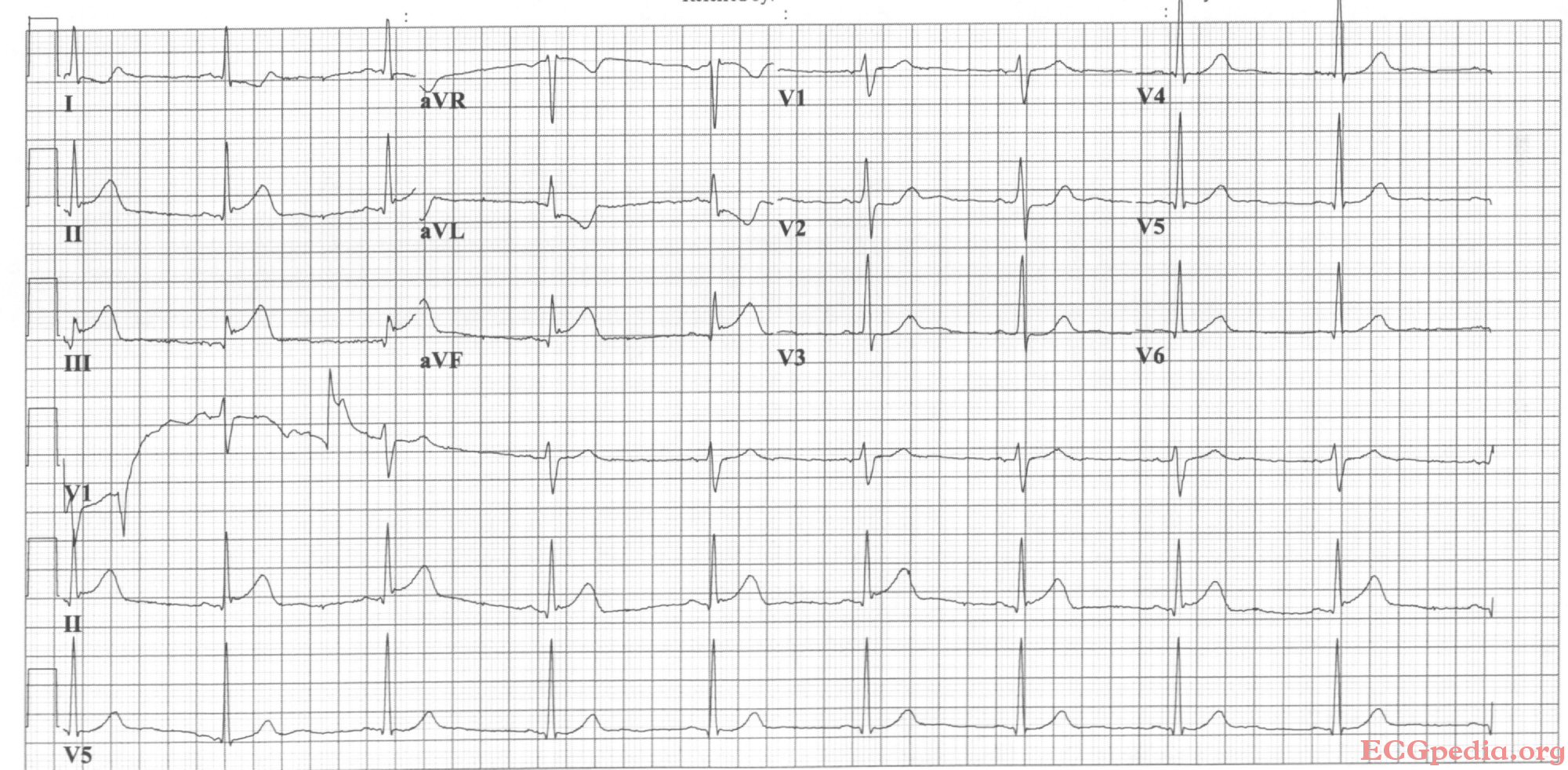
Copyleft image obtained courtesy of, http://en.ecgpedia.org/wiki/Main_Page
Shown below is an EKG demonstrating changes during acute posterolateral MI depicting ST depression in precordial leads V2-V6.

Copyleft image obtained courtesy of, http://en.ecgpedia.org/wiki/Main_Page
Infero-Posterior Myocardial Infarction
Shown below is an EKG with ST depression in V1, V4, tall R in V2. ST elevation in II, III, aVF, V5 and V6.
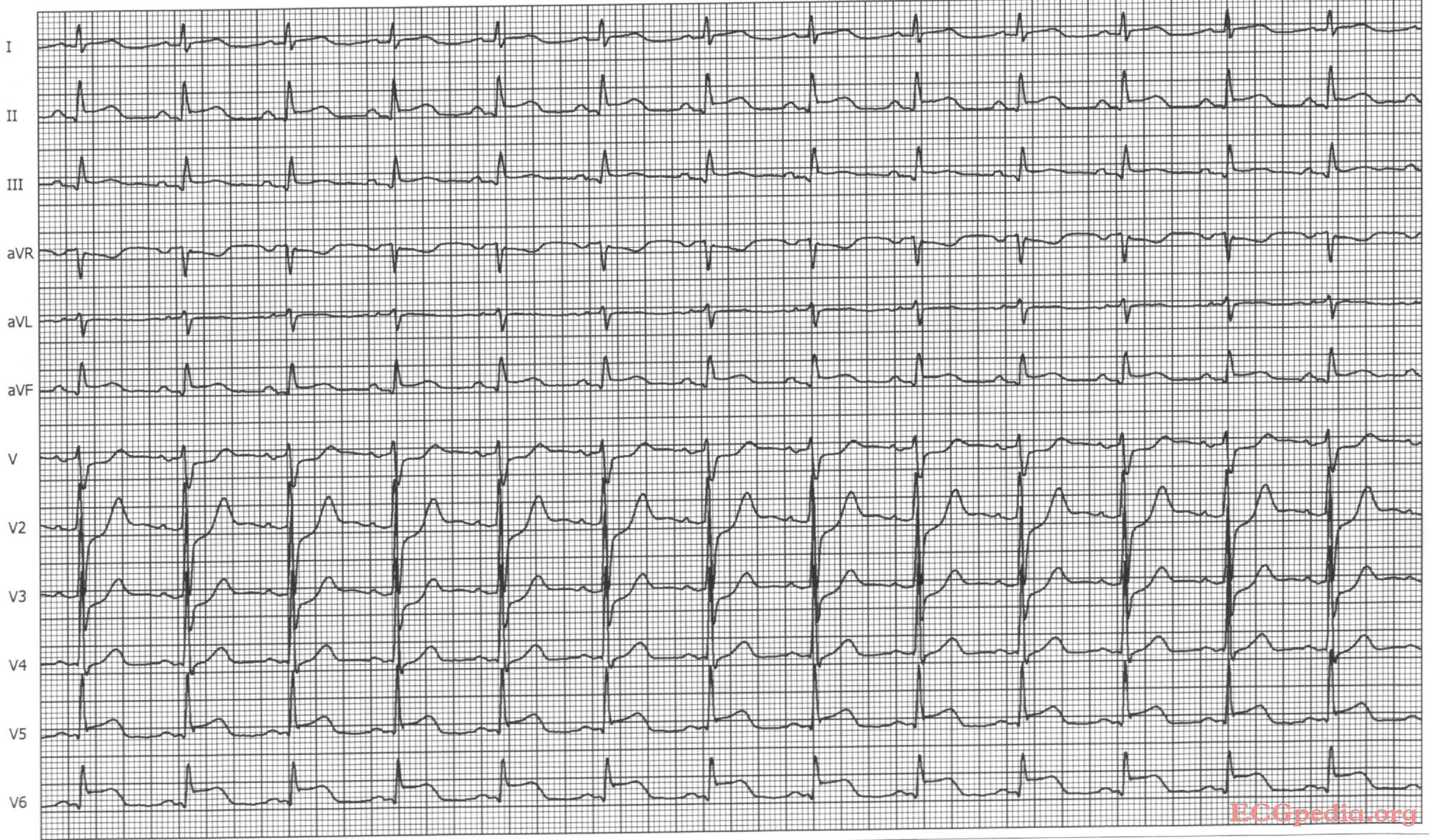
Copyleft image obtained courtesy of, http://en.ecgpedia.org/wiki/Main_Page
Shown below is an EKG with sinus bradycardia with first degree AV block and inferior-posterior-lateral myocardial infarction.

Copyleft image obtained courtesy of, http://en.ecgpedia.org/wiki/Main_Page
Shown below is an EKG depicting sinus bradycardia with inferior-lateral myocardial infarction.

Copyleft image obtained courtesy of, http://en.ecgpedia.org/wiki/Main_Page
Shown below is an EKG illustrating inferior-posterior myocardial infarction with complete AV block and ventricular escape rhythm with RBBB pattern and left axis, followed by sinus rhythm.

Copyleft image obtained courtesy of, http://en.ecgpedia.org/wiki/Main_Page
Shown below is an EKG demonstrating atrial fibrillation and inferior-posterior myocardial infarction.
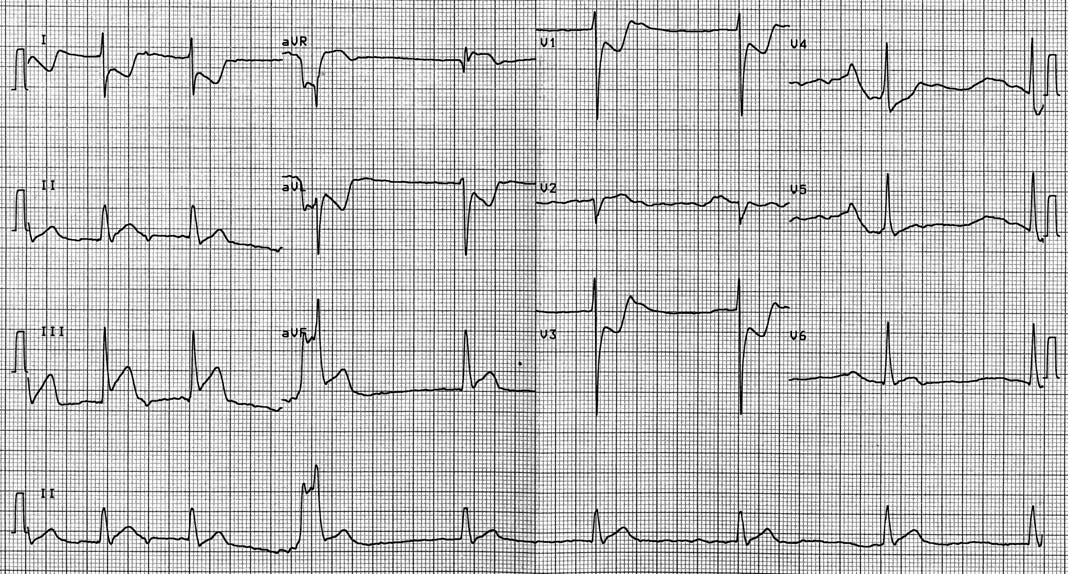
Copyleft image obtained courtesy of, http://en.ecgpedia.org/wiki/Main_Page
Shown below is an EKG demonstrating inferior-posterior-lateral myocardial infarction with a nodal escape rhythm
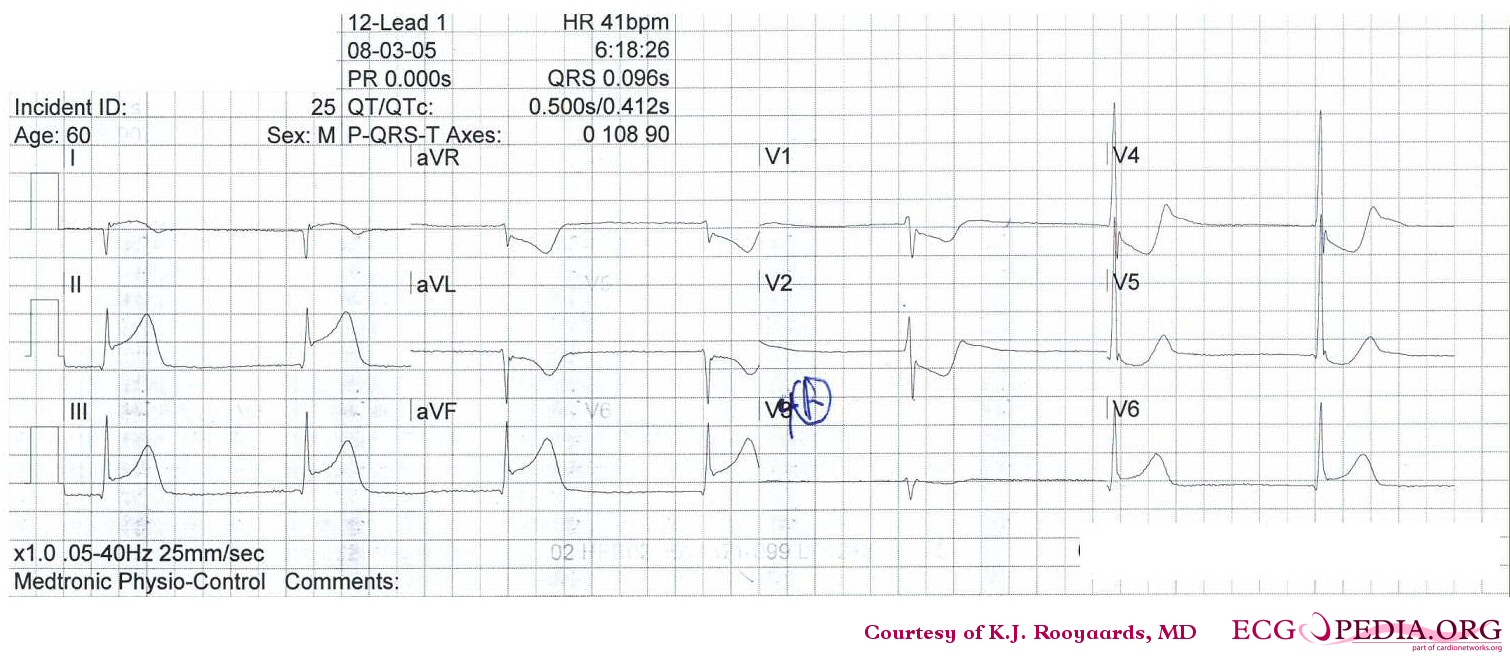
Copyleft image obtained courtesy of, http://en.ecgpedia.org/wiki/Main_Page
Shown below is an EKG showing ST elevation MI.
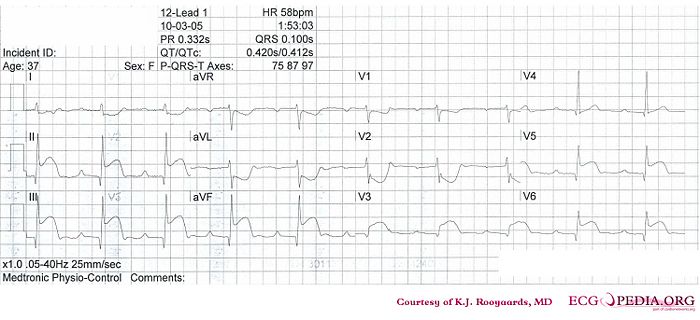
Copyleft image obtained courtesy of, http://en.ecgpedia.org/wiki/File:De-KJcasus13.jpg
Shown below is an EKG showing ST elevation MI.

Copyleft image obtained courtesy of, http://en.ecgpedia.org/wiki/File:De-Ami0010.jpg
Right Ventricular Myocardial Infarction
Shown below is an EKG demonstrating ST elevation in lead V1 and aVR; reversal of V6.

Copyleft image obtained courtesy of, http://en.ecgpedia.org/wiki/Main_Page
Shown below is an EKG demonstrating STEMI changes in the right precordial leads.

Copyleft image obtained courtesy of, http://en.ecgpedia.org/wiki/Main_Page
Shown below is an EKG demonstrating clear ST elevation in the right precordial leads. A coronary angiography revealed a proximal right coronary artery occlusion.
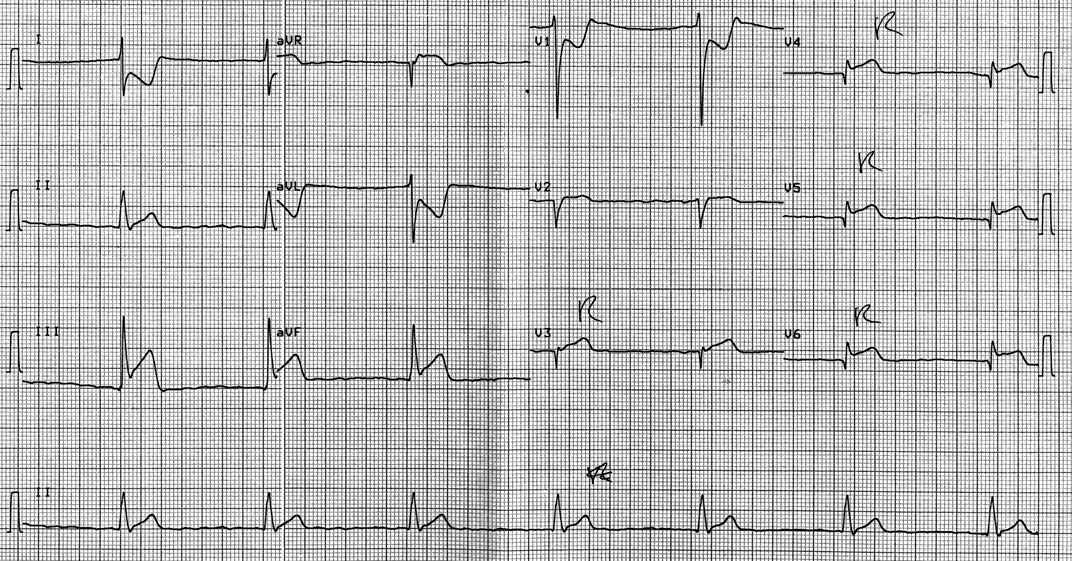
Copyleft image obtained courtesy of, http://en.ecgpedia.org/wiki/Main_Page